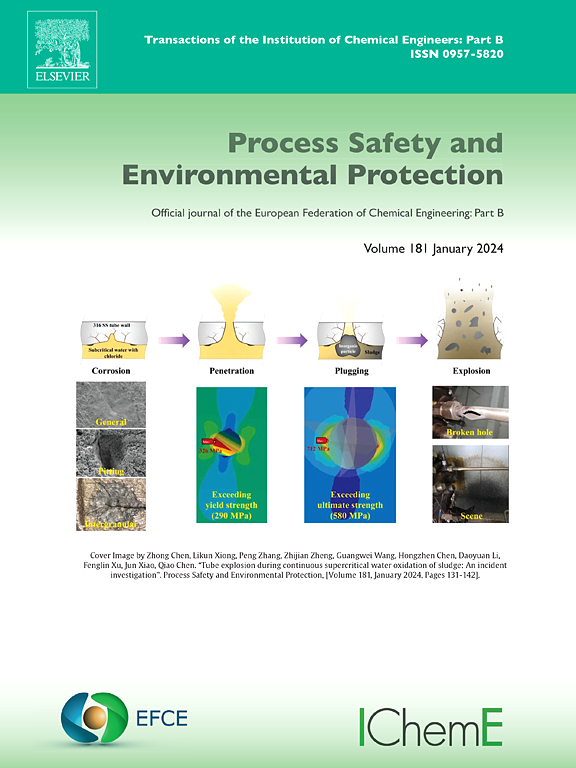Migration and transformation mechanisms of heavy metals and PAHs during hydrothermal treatment of food waste digestate
IF 7.8
2区 环境科学与生态学
Q1 ENGINEERING, CHEMICAL
引用次数: 0
Abstract
Hydrothermal treatment (HT) is a suitable disposal strategy for pollutant removal and nutrient recovery from food waste digestate (FWD). However, the fate of heavy metals (HMs) and polycyclic aromatic hydrocarbons (PAHs) during HT remains poorly understood. Here, the distribution, transformation, and ecological risks of HMs and PAHs in FWD during HT were systematically investigated. The results revealed that HT immobilized most HMs in hydrochar, exhibiting enrichment factors of 79 %-116 %. The bioavailability of HMs in hydrochar was decreased significantly at 200–220 °C. Specifically, the bioavailability of As, Cd, Cu, Ni, and Pb in hydrochar was decreased by 11.9 %, 57.1 %, 100 %, 72.2 %, and 84.0 % compared with that in raw FWD, respectively. Meanwhile, HT resulted in a 40.4 % reduction of total PAH contents at 140 °C compared to FWD. The polymerization of organic matter increased the aromaticity of derived hydrochar while converting low-ring PAHs into high-ring PAHs at 160–180 °C. The maximum reduction of total PAH contents (42.7 %) occurred at 180 °C. Higher temperatures (200–220 °C) favored lignin decomposition to produce PAH precursors, which simultaneously polymerized into new PAHs. These findings provide a comprehensive understanding of HMs and PAHs transformation mechanisms during HT, offering valuable guidance for optimizing FWD management processes and ensuring the safe utilization of hydrothermal products.
食物垃圾消化液水热处理过程中重金属和多环芳烃的迁移转化机理
水热处理(HT)是一种适合去除食物垃圾中污染物和回收营养物质的处理策略。然而,重金属(HMs)和多环芳烃(PAHs)在高温期间的命运仍然知之甚少。在此基础上,系统地研究了高温期间FWD中HMs和PAHs的分布、转化及生态风险。结果表明,HT在烃类中固定化了大部分HMs,富集系数为79% ~ 116%。在200 ~ 220℃时,HMs在烃类中的生物利用度显著降低。其中,As、Cd、Cu、Ni和Pb的生物利用度分别比生生FWD降低11.9%、57.1%、100%、72.2%和84.0%。同时,与FWD相比,高温处理在140℃时总多环芳烃含量降低了40.4%。在160 ~ 180℃的温度下,有机物的聚合提高了衍生烃类的芳香性,同时将低环多环芳烃转化为高环多环芳烃。总多环芳烃含量在180℃时最大降幅为42.7%。较高的温度(200-220℃)有利于木质素分解产生多环芳烃前体,同时聚合成新的多环芳烃。这些发现有助于全面了解高温过程中HMs和PAHs的转化机制,为优化水热管理流程和确保水热产物的安全利用提供有价值的指导。
本文章由计算机程序翻译,如有差异,请以英文原文为准。
求助全文
约1分钟内获得全文
求助全文
来源期刊

Process Safety and Environmental Protection
环境科学-工程:化工
CiteScore
11.40
自引率
15.40%
发文量
929
审稿时长
8.0 months
期刊介绍:
The Process Safety and Environmental Protection (PSEP) journal is a leading international publication that focuses on the publication of high-quality, original research papers in the field of engineering, specifically those related to the safety of industrial processes and environmental protection. The journal encourages submissions that present new developments in safety and environmental aspects, particularly those that show how research findings can be applied in process engineering design and practice.
PSEP is particularly interested in research that brings fresh perspectives to established engineering principles, identifies unsolved problems, or suggests directions for future research. The journal also values contributions that push the boundaries of traditional engineering and welcomes multidisciplinary papers.
PSEP's articles are abstracted and indexed by a range of databases and services, which helps to ensure that the journal's research is accessible and recognized in the academic and professional communities. These databases include ANTE, Chemical Abstracts, Chemical Hazards in Industry, Current Contents, Elsevier Engineering Information database, Pascal Francis, Web of Science, Scopus, Engineering Information Database EnCompass LIT (Elsevier), and INSPEC. This wide coverage facilitates the dissemination of the journal's content to a global audience interested in process safety and environmental engineering.
 求助内容:
求助内容: 应助结果提醒方式:
应助结果提醒方式:


